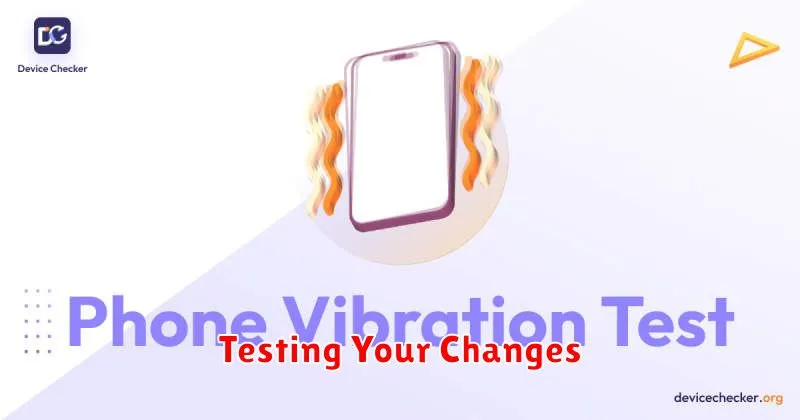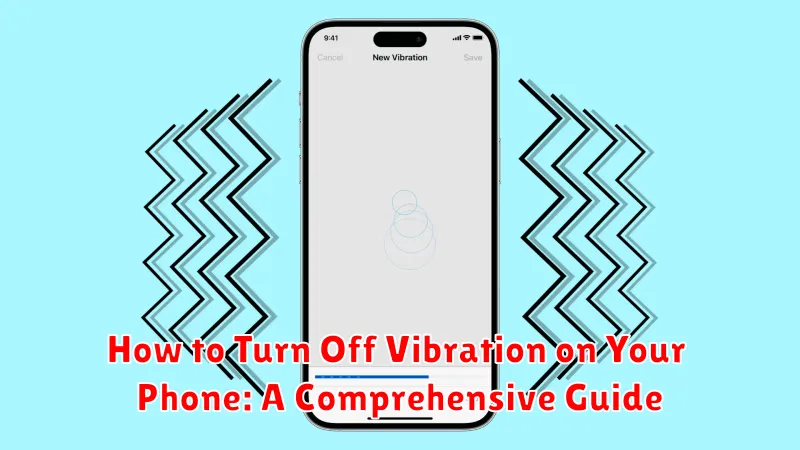Is your phone constantly buzzing in your pocket? Do you find the vibration feature more distracting than helpful? This comprehensive guide will show you exactly how to turn off vibration on your phone, offering clear, step-by-step instructions for various devices and operating systems. Whether you’re looking to silence specific notifications, customize vibration patterns, or eliminate vibrations entirely, this guide provides the solutions you need to regain control over your phone’s vibration settings.
Learning how to turn off vibration on your phone can significantly improve your mobile experience. From eliminating distractions during meetings to conserving battery life, understanding your phone’s vibration settings is essential. This guide covers a range of scenarios, including silencing calls, text messages, and other app notifications. We’ll delve into the specifics of managing vibration on both Android and iOS devices, ensuring you have the knowledge to personalize your settings and achieve the perfect balance of notification awareness and peaceful quiet.
Understanding Vibration Settings on Your Phone
Your phone’s vibration settings control when and how your device vibrates. These settings allow you to customize the vibration behavior for various events, such as incoming calls, notifications, and keyboard interactions. Understanding these settings is the first step toward managing your phone’s vibration preferences.
Typically, vibration settings are categorized by event type. This means you can independently control vibration for different functions. For example, you might prefer vibration for calls but not for notifications. This granular control allows you to fine-tune your phone’s behavior to your specific needs.
Navigating to these settings usually involves accessing your phone’s main settings menu and locating the “Sound” or “Sound & Vibration” section. The specific location and labeling might vary slightly depending on your phone’s operating system and manufacturer.
Steps to Turn Off Vibration for Calls
Silencing your phone’s vibration for incoming calls can be easily accomplished through your device’s settings. The specific steps may vary slightly depending on your phone’s operating system (Android or iOS) and manufacturer.
For Android users, generally, you can follow these steps:
- Open the Settings app.
- Navigate to Sound & vibration (or a similarly named setting).
- Locate the Ringtone & vibration or Vibration & haptics option.
- Find and disable the Vibrate for calls setting. This may involve toggling a switch or unchecking a box.
iOS users typically follow a different path:
- Open the Settings app.
- Select Sounds & Haptics.
- Under the Ringer and Alerts section, disable the Vibrate on Ring option.
Disabling Vibration for Notifications
Most phones allow you to disable vibration for notifications separately from call vibrations. This allows you to stay aware of incoming notifications without the constant buzzing.
Typically, you can find these settings within your phone’s main settings menu under “Sound & Notification” or a similarly named section. Look for an option labeled “Notifications” or “App notifications.” Within this section, you should find a toggle or switch specifically for notification vibrations.
Some phones offer granular control, allowing you to disable vibrations for specific apps. This is useful if you only want to disable vibrations for certain noisy apps while keeping them enabled for others. Look for a list of apps or a “Per-app settings” option to customize vibration behavior on a per-app basis.
Remember to save your changes after adjusting the notification vibration settings.
Customizing Vibration Patterns for Different Contacts
While turning vibration off completely is an option, many users prefer to customize vibration patterns for different contacts. This allows for silent notification of who is contacting you without needing to look at your phone. Most modern smartphones offer this functionality.
Typically, you can access this feature through your phone’s contact list. Select the desired contact and look for an “edit” or “options” menu. Within these settings, you should find options related to ringtones and vibration. Look for “vibration pattern” or a similarly labeled setting.
From here, you can usually choose from pre-set vibration patterns or even create your own custom pattern in some cases. This level of customization allows you to easily distinguish between calls from family, friends, colleagues, or other important contacts without having to visually check your device.
Turning Off Keyboard Vibration

Keyboard vibration can be a useful feedback tool, but some users find it distracting or prefer to conserve battery life. Most smartphones allow you to disable this feature easily within the settings.
Typically, keyboard vibration settings are located within the “Sound & Vibration” or “Language & Input” section of your phone’s settings. The exact path may vary slightly depending on your phone’s manufacturer and operating system.
Android Devices: Generally, you can find the setting by navigating to Settings > Sound & Vibration > Keyboard > Haptic Feedback. Disable this option to turn off keyboard vibration. Some keyboards, like Gboard, may have their own specific vibration settings within the keyboard app itself.
iOS Devices: On iPhones, you can typically adjust keyboard vibration by going to Settings > Sounds & Haptics > Keyboard Feedback. Toggle off the “Haptic” option to disable vibration. This will also affect other haptic feedback features related to keyboard interaction.
Managing Vibration in Specific Apps
Many apps allow you to customize vibration settings independently of your system-wide preferences. This gives you granular control over which apps can use vibration and when. The process for managing these settings varies slightly depending on the operating system.
Android
On most Android devices, you can manage app-specific vibration settings through the app’s own settings menu. Look for options related to notifications or sounds. Be aware that not all apps offer individual vibration controls.
iOS
iOS offers more centralized control. You can adjust vibration settings for individual apps through the main Settings app. Navigate to Notifications, select the desired app, and then modify the “Sounds” settings, including vibration. This allows you to enable or disable vibration for various notification types within the app.
Troubleshooting Vibration Issues
If you’ve followed the steps to disable vibration but your phone still vibrates, there may be underlying issues requiring troubleshooting. Here’s a guide to help you resolve these problems.
Checking System Settings
Verify Vibration Settings: Double-check your phone’s sound and vibration settings to ensure vibration is indeed turned off. Sometimes, accidental toggles can re-enable it.
Restart Your Device: A simple restart can often resolve temporary software glitches that may be affecting vibration functionality.
Advanced Troubleshooting
Check for Updates: Ensure your phone’s operating system and apps are up-to-date. Outdated software can sometimes cause unexpected behavior.
Safe Mode: Boot your phone into safe mode to determine if a third-party app is causing the vibration. If the issue disappears in safe mode, an app is likely the culprit.
Factory Reset (Last Resort): If all else fails, a factory reset can resolve persistent software problems. Remember to back up your data before proceeding, as this will erase all information on your device.
Testing Your Changes

After adjusting your vibration settings, it’s crucial to test the changes to ensure they’ve been applied correctly. This simple process helps confirm your phone behaves as expected and prevents unexpected vibrations in the future.
There are several easy ways to test your vibration settings. One common method is to place your phone on a flat surface and then perform actions that typically trigger vibration. For example, you can send yourself a text message or have a friend call you. If you’ve successfully disabled vibration, your phone should remain still.
Alternatively, many phones offer a built-in vibration test feature within the sound settings. Look for an option labeled “Vibration Test” or similar. Activating this feature will typically cause your phone to vibrate briefly, allowing you to confirm its functionality even if other vibration triggers are disabled.

